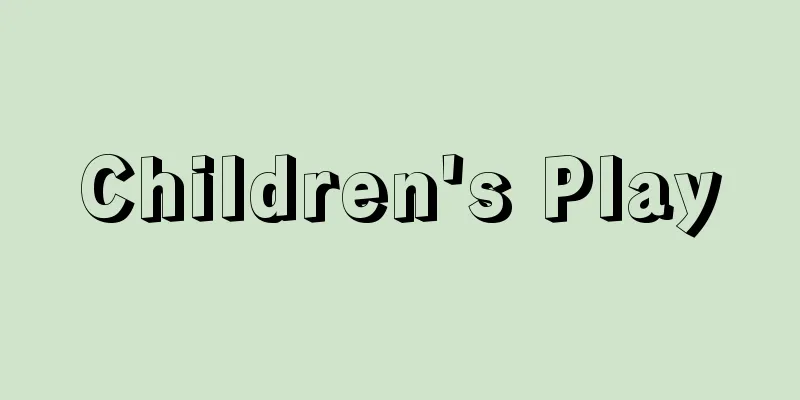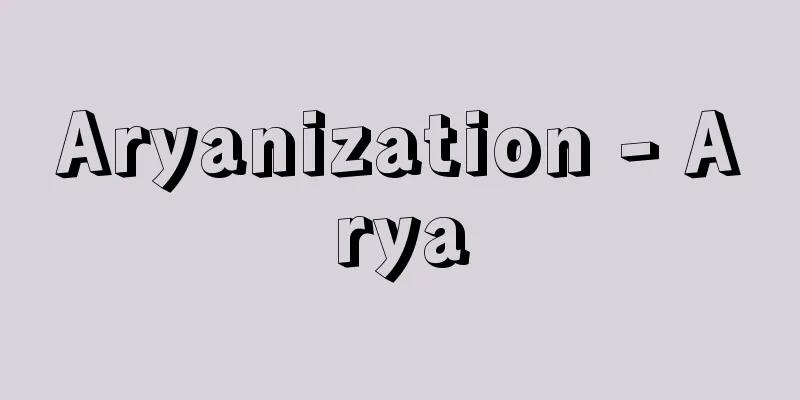Children's Play

|
A general term for plays performed for children. In this case, children refers to those aged 3 to 18 (preschoolers, elementary school students, junior high school students, and high school students), and is often understood as a broad category of children's and young people's theater. The Tokyo Metropolitan Selection of Outstanding Children's Theater also includes plays for high school students. Children's plays are performed by adult theater troupes or by adults and children working together. Although the target audience is children, they can also be considered "theater for parents and children to watch together." Plays performed by children at school are called "school plays," and are performed for educational purposes (drama education), including "dramatic play" for young children. [Yokomizo Sachiko] Children and theatreChildren's involvement in theater dates back a long time. In Europe, boys' choirs and boys' theater troupes were established in churches around the 14th century, but these are different from today's children's theater. In Japan, there are Dobu (children's dance), Kosushi (little mantra), and Jido Bugaku (children's dance) from the mid-Heian period, Chigo Ennen (children's ennen) and Sarugaku (children's dance) from the end of the Heian period to the Kamakura and Muromachi periods. Child actors (kokata) played an active role in Wakashu Kabuki (young men's kabuki), Noh, and Kyogen. After the Horeki period (1751-63), "chinko shibai" (penis play) and "kubifuri ningyo" (head-bouncing doll) were born in Kyoto and Osaka as children's plays, but these were training for child Kabuki actors. [Yokomizo Sachiko] Japanese Children's TheatreBirth and developmentChildren's theater in Japan began when Iwaya Sazanami, who returned from Germany, proposed "Otogi Shibai" (fairy tale plays), and in 1903 (Meiji 36) Kawakami Otojiro's troupe performed "The Trial of the Fox" and "The Floating Kokyu" at the Hongo-za Theater in Tokyo. Later, Kawakami Otojiro worked with fairy tale writers such as Kurushima Takehiko to organize a children's theater company called "Otogi Shibai," which held "Yurakuza Otogi Shibai Children's Day" on Sundays and holidays, contributing to the development of children's theater. In addition, many theater companies performed fairy tale plays, including the "Family Drama Association" of Ishikawa Mokushu and Amano Kijihiko, the "Modern Drama Association" of Kinugawa Kujaku and Yamakawa Urajiro, the "Kosuzumeza" of Ichikawa Sumizo and Kawarasaki Chojuro, and the "Mebaeza" of Okada Yachiyo and Aoyama Masao. These were child-centered art movements, but they lacked theoretical unity. The first performance in Japan of Maeterlinck's fairy tale play "The Blue Bird" was the first performance by Minshuza in 1920 (Taisho 9) (Yurakucho, Tokyo), with a star-studded cast including the first Mizutani Yaeko as Chiruchiru, Natsukawa Shizue as Michiru, and Tomoda Kyosuke as the dog. It was Tsubouchi Shoyo who broke away from fairy tale plays and established children's plays by children for children. The first performance, "The Country Mouse and the Tokyo Mouse," was held at the Yurakucho Theater in 1922. To back up his theories, he wrote many scripts such as "Children's Plays for the Home" and "Small Scripts for Schools," and personally supervised the directing. It was Shoyo's achievement in the children's theater movement that his scripts began to be published in school textbooks. Following Shoyo, other active children's theatre companies included the Asano Children's Drama School led by Asano Toshiro (1898-1961) and the School Drama Study Group led by Ochiai Sozaburo (1910-95), but the founding of the Toudo Theatre Company (1928) by Miyazu Hiroshi (1911-98), who attempted to pursue realism in children's theatre, believing that child roles should be played by children themselves, left a major mark in the history of children's theatre. After the Second World War, the new theatre companies Haiyuza, Bungakuza and Mingei performed children's plays. The success of Marshak's The Forest is Alive (1954) at Haiyuza Children's Theatre had a major impact on children's theatre companies and new theatre companies. The Nissay Masterpiece Theatre's "Musical Plays for Children" series, launched in 1964 (Showa 39) by the Shiki Theatre Company, has continued without interruption, and by July 1998 (Heisei 10) the number of children invited from around the country had exceeded 5 million. The activities of professional adult theatre companies are also noticeable, with the Zenshinza Youth Theatre touring the country every year. [Yokomizo Sachiko] current situationThere are more than 200 theater companies for children and adolescents, including the aforementioned companies, including puppet theaters, but as of 2002, there are only 76 professional theater companies affiliated with the Japan Children's and Youth Theater Cooperative (Jienkyo). It is difficult to get a complete picture, as there are children's theater companies and amateur theater companies that only lend their child actors to television and the stage. In 2001, the 76 theater companies affiliated with Jienkyo performed 385 plays. In the same year, there were 20,536 performances, with an audience of 7.43 million people, and both the number of performances and the audience are on the decline. 70% of the income of children's theater companies comes from school performances, but with the implementation of a five-day week, an increasing number of schools are canceling performances, and at the same time, the declining birthrate has reduced performance income, and the tightness of the theater company's economy has had an impact on their creative side. The Children's Playwrights Association, founded in 1948 (Showa 23) with the aim of "providing excellent theater for children," changed its name to the Japan Children's Theater Association in 1983. With funding from the Agency for Cultural Affairs, the Association has produced successful results in the promotion of children's theater through its "Children's Theater Regional Tour," "Children's Theater Nationwide Remote Island Tour," and "Tour for Blind, Deaf, and Special Needs School Children and Youth." There are the "Saida Takashi Drama Award" for playwrights, the "Mrs. O Children's Theater Award" for women involved in children's theater companies, and the "Ochiai Sozaburo Children and Youth Theater Fund," which subsidizes children's theater. The "Children's Theater National Center," an appreciation movement, is also important in improving children's theater. Many issues remain to be addressed, such as the uniqueness of children's theater and how it should play a role in education. The contents of children's plays often deal with themes such as fairy tales, family, war, and social issues. Barefoot Gen, a masterpiece written by Nakazawa Keiji (1939-), which depicts the horrors of war, was even made into a musical (first performed by Kiyama Office in 1996). [Yokomizo Sachiko] Children's Theatre from around the worldNational children's theaters in the former Soviet Union and Eastern European countries used to perform children's plays of a high artistic standard. However, with the collapse of the Soviet Union, government support decreased and the number of these theaters dwindled. Theater companies in Western countries have their own theaters, are rooted in the local community, and are often experimental. In the United States, university theater companies, community theaters, museums, and art galleries perform a wide variety of children's plays with support from foundations, states, and cities. Dramatic arts students studying at over 400 universities are being trained as talent for children's theater companies. International organizations based in Japan include the Japan Center of the International Association for Theatre for Children and Youth (ASSITEJ), the Japan Center of Japan Unima (International Puppet Theatre Federation), and the Japan Center of the International Theatre Institute (ITI). ASSITEJ is a world organization of theater professionals for young people that was formed in 1965. In 1979, the ASSITEJ Japan Center was established, becoming the 36th member country. As of 2002, there are 72 member countries, including 63 full members and 9 associate members. Aiming to improve the artistic standard of theater, a world-class youth theater festival and international conference are held every three years. At the Stockholm Conference (1990), ASSITEJ was divided into two factions: the French artistic supremacist faction and the theater education faction from China, the United States, the United Kingdom, Austria, and other countries. The rise of Asia and Africa also forced ASSITEJ to reconsider the idea of developing European-style expertise, and ASSITEJ began to look at non-European cultures. Following the Asian Games in 1999, the 14th World Games was held in Seoul, South Korea in 2002, with participation from 12 Korean theatre companies as well as theatre companies from 13 other countries, and five productions from four theatre companies from Japan. [Yokomizo Sachiko] "History of Japanese Children's Theater" by Tomita Hiroyuki (1976, Tokyo Shoseki) ▽ "The History of Japanese Children's Theater - 80 Years of Children's Theater, Puppet Theater, and School Theater" (1984), edited and published by the Japan Children's Theater Association ▽ "30 Years of Children's Theater Tours" (1990), edited and published by the Japan Children's Theater Association ▽ "My Long March - 50 Years of Children's Theater" by Tada Toru (1995, Otsuki Shoten) ▽ "Theater Company, Children, Society - The Current State and Issues of Children's Theater" by the Children's Theater Research Project (1996, Geidankyo Publishing Division) ▽ "50 Years of the Japan Children's Theater Association" (1998), edited and published by the Japan Children's Theater Association ▽ "Storytelling: The History of Boys' Theater" by Ochiai Sozaburo (2000, Japan Children's Theater Association) ▽ "Education and the Arts: A New Relationship - Learning from Overseas Cases," edited by Geidankyo and Performing Arts and Culture Information Center (2002, Geidankyo Publishing Division)" ▽ "Young Theater" (published twice a year, Youth Theater Center)" ▽ "Children's Theater" (monthly newsletter, Japan Children's Theater Association)" ▽ "Ashitaji" (quarterly magazine, Ashitaji Japan Center)" ▽ "Children's White Paper, various years' editions, edited by the Japan Society for the Protection of Children (Kusado Bunka)" ▽ "Children's Performing Arts Guide Editorial Committee, various years' editions, Children's Performing Arts Guide (Geidankyo Publishing Division)" [References] | | | | | | | | | |Source: Shogakukan Encyclopedia Nipponica About Encyclopedia Nipponica Information | Legend |
|
児童のために演じられる演劇の総称。この場合の児童とは3歳から18歳まで(幼児、小学生、中学生、高校生)をさし、広範囲に児童青少年演劇ととらえられることが多い。「東京都優秀児童演劇選定」の対象は、高校生向きも含まれる。 児童劇は大人の劇団、または大人と児童の協力で演じられる。観客の対象は児童ではあるが、「親と子がいっしょに見る演劇」という性格もある。学校で児童が演じる劇は「学校劇」とよばれ、幼児の「劇遊び」を含めて教育的目的(演劇教育)のもとに行われている。 [横溝幸子] 子供と演劇子供が演劇にかかわるようになった歴史は古い。ヨーロッパでは14世紀ごろから教会に少年聖歌隊が生まれ、少年劇団がつくられたが、これは今日の児童劇とは異なる。 日本では平安中期の童舞(どうぶ)、小咒師(こすし)、児童舞楽、平安末期から鎌倉・室町にかけての稚児延年(ちごえんねん)、稚児猿楽(さるがく)などがある。若衆歌舞伎(わかしゅかぶき)や能、狂言は子役(子方(こかた))が活躍した。宝暦(1751~63)以降、子供芝居として京坂(けいはん)に「ちんこ芝居」「首振り人形」が誕生したが、これは歌舞伎の子役たちの修業であった。 [横溝幸子] 日本の児童演劇誕生と発展日本における児童劇は、ドイツから帰国した巌谷小波(いわやさざなみ)が「お伽芝居(おとぎしばい)」を提唱し、1903年(明治36)、川上音二郎一座が東京・本郷座で『狐(きつね)の裁判』『浮かれ胡弓(こきゅう)』を上演したのが始まりである。その後、川上音二郎は久留島武彦(くるしまたけひこ)らの童話作家と図り、「お伽芝居」という子供の劇団を組織、日曜・祝祭日に「有楽座お伽芝居子供日」を興行し、児童劇発展に寄与した。そのほかにも、石川木舟(もくしゅう)、天野雉彦(きじひこ)の「家庭劇協会」、衣川孔雀(きぬがわくじゃく)、山川浦路(うらじ)の「近代劇協会」、市川寿美蔵(すみぞう)、河原崎長十郎(かわらさきちょうじゅうろう)の「小寿々女座(こすずめざ)」、岡田八千代、青山圭男(まさお)らの「芽生座(めばえざ)」など多くの劇団が童話劇を上演した。これらは児童本位の芸術運動ではあったが、理論的統一が欠けていた。なお、メーテルリンクの童話劇『青い鳥』の日本初上演は1920年(大正9)の民衆座第1回公演(東京・有楽座)で、初代水谷八重子のチルチル、夏川静江のミチル、友田恭助(きょうすけ)の犬という豪華配役であった。 童話劇から脱皮、子供のための子供による児童劇を確立したのは坪内逍遙(しょうよう)である。1922年、有楽座で第1回公演『田舎(いなか)のねずみと東京のねずみ』を上演。理論の裏づけのために多くの脚本「家庭用児童劇」「学校用小脚本」などをつくり、自ら演出指導した。学校の教科書に脚本が掲載されるようになったのは、逍遙の児童劇運動の功績である。逍遙に続く児童劇団の活躍は浅野歳郎(としろう)(1898―1961)の「浅野児童劇学校」、落合聡三郎(そうざぶろう)(1910―95)の「学校劇研究会」があるが、児童の役は児童によって演じられるべきだと児童演劇のリアリズム追求を試みた宮津博(ひろし)(1911―98)による劇団東童の設立(1928)は、児童演劇史上、大きな足跡を残した。 第二次世界大戦後、新劇の劇団である俳優座、文学座、民芸が児童劇を上演。俳優座こども劇場におけるマルシャーク作『森は生きている』(1954)の成功は、児童劇団や新劇団に大きな影響を与えた。1964年(昭和39)からスタートされた劇団四季によるニッセイ名作劇場「こどものためのミュージカル・プレイ」は中断することなく続き、98年(平成10)7月の全国の招待児童数は500万人を突破した。前進座青少年劇場も毎年全国巡演を行うなど、大人の専門劇団の活躍が目だつ。 [横溝幸子] 現状前述の劇団を含めて、児童青少年を対象とする劇団は、人形劇団などを加えて200を超えているが、職業劇団として日本児童・青少年演劇劇団協同組合(児演協)に加盟する劇団は2002年現在76劇団にすぎない。テレビや舞台に子役を貸すだけの児童劇団やアマチュア劇団もあるため、全体的把握は困難である。2001年は児演協加盟76劇団が385本を上演した。同年の公演回数は2万0536回、観客動員数は743万人であり、公演回数、観客動員数ともに減少傾向にある。児童劇団の収入のうち、7割は学校公演から得ているが、週5日制の実施で公演を中止する学校が増え、同時に少子化現象で公演収入が減少し、劇団経済の逼迫(ひっぱく)が創造面に影響を及ぼしてきた。 「児童に優れた演劇を」と1948年(昭和23)設立された児童劇作家協会が、58年に「日本児童演劇協会」と改称。同協会が文化庁の助成を得て行う「児童演劇地方巡回公演」「児童演劇全国離島巡回公演」「盲・聾(ろう)・養護学校児童青少年巡回公演」は、児童演劇普及に成果をあげた。劇作家のための「斎田喬(さいだたかし)戯曲賞」、児童劇団にかかわる女性のための「O(オー)夫人児童演劇賞」、児童演劇助成の「落合聡三郎児童青少年演劇基金」がある。鑑賞運動体である「子ども劇場全国センター」も、児童演劇向上のために重要である。児童演劇の独自性を求め、教育における役割をどう考えるか、多くの課題が残されている。児童劇の内容は童話、家族、戦争、社会問題をテーマとしたものが多く、戦争の悲惨さを描いた名作として知られる中沢啓治(けいじ)(1939― )原作の『はだしのゲン』はミュージカルにもなった(1996・木山事務所初演)。 [横溝幸子] 世界の児童演劇旧ソ連や東欧諸国の国立児童劇場が芸術的に高水準の児童劇を上演してきた。しかし、ソ連崩壊で国の支援が減り、先細り状態になった。欧米諸国の劇団は独自の劇場をもち、地域に根を下ろし、実験的試みも多い。アメリカは大学の劇団、コミュニティ・シアター、博物館、美術館などが財団や州、市の助成で多彩な児童劇を上演。400以上の大学で学ぶ演劇芸術専攻の学生が、児童劇団の人材として育っている。 日本に置かれている国際組織には、国際児童青少年演劇協会(ASSITEJ(アシテジ))日本センター、日本ウニマ(国際人形劇連盟日本センター)、国際演劇協会(ITI)日本センターがある。アシテジは1965年に結成された青少年のための演劇専門家の世界組織で、79年にアシテジ日本センターが設立され、36番目の加盟国となった。2002年現在、正会員世界63か国、準会員9か国の計72か国が加盟。演劇の芸術的水準向上を目ざし、3年ごとに世界的規模の青少年演劇フェスティバルと国際会議が開催される。ストックホルム大会(1990)でアシテジはフランスの芸術至上主義派と中国、アメリカ、イギリス、オーストリアなどの演劇教育派が対立した。またアジア、アフリカの台頭により、ヨーロッパ的な専門性の発展というアイデアの見直しを迫られ、アシテジは非ヨーロッパ諸文化へと目を向け始めた。1999年のアジア大会に続いて、2002年に韓国のソウルで第14回世界大会が開催され、韓国の12劇団のほか、海外13か国の劇団が参加、日本からは4劇団5作品が参加した。 [横溝幸子] 『富田博之著『日本児童演劇史』(1976・東京書籍)』▽『日本児童演劇協会編・刊『日本児童演劇の歩み――児童劇・人形劇・学校劇80年の年表』(1984)』▽『日本児童演劇協会編・刊『児童演劇地方巡回公演30年のあゆみ』(1990)』▽『多田徹著『ぼくのロングマーチ――児童演劇50年』(1995・大月書店)』▽『児童演劇研究プロジェクト著『劇団 子ども 社会――児童演劇の現状と課題』(1996・芸団協出版部)』▽『日本児童演劇協会編・刊『日本児童演劇協会50年史』(1998)』▽『落合聡三郎著『聞き語り 少年演劇の歩み』(2000・日本児童演劇協会)』▽『芸団協・芸能文化情報センター編『教育と芸術・新たな関係――海外の事例に学ぶ』(2002・芸団協出版部)』▽『『少年演劇』(年2回発行・少年演劇センター)』▽『『児童演劇』(月刊機関紙・日本児童演劇協会)』▽『『アシテジ』(季刊誌・アシテジ日本センター)』▽『日本子どもを守る会編『子ども白書』各年版(草土文化)』▽『「子ども舞台芸術ガイド」編集委員会編『子ども舞台芸術ガイド』各年版(芸団協出版部)』 [参照項目] | | | | | | | | | |出典 小学館 日本大百科全書(ニッポニカ)日本大百科全書(ニッポニカ)について 情報 | 凡例 |
<<: Children's Charter - Jido Kensho
Recommend
eulachon
...It is eaten grilled with salt, but it is not v...
Book of Jonah (English: yônāh, Hebrew)
One of the twelve minor prophets in the Old Testa...
Owen, J.
…After the Restoration, the Puritans quickly disi...
Third Princess - Onnasan no Miya
A woman who appears in "The Tale of Genji.&qu...
Kakeyu [Hot Spring] - Kakeyu
This is a national health resort hot spring locate...
Lord Chancellor
… [Foreign Systems] (1) United Kingdom Judges are...
Odontocidium - Odontocidium
...In Japan, many species flower from spring to a...
Shirley, James
Born: September 1596, London [Died] October 29, 16...
Station child - Ekishi
〘 noun 〙 Laborers requisitioned from post towns to...
Kutuzov, Mikhail Illarionovich
Born: September 16, 1745, Petersburg Died: April 2...
Concert of Europe
A system of international dispute resolution throu...
Mr. Sakai
A senior retainer of the Tokugawa Shogunate. Ther...
Corona discharge - Corona discharge
A type of gas discharge. It is a partial discharg...
Gran
…It borders Czechoslovakia. It is called Gran in ...
SS (Water Quality)
…Abbreviated as SS. Substances suspended in water...









